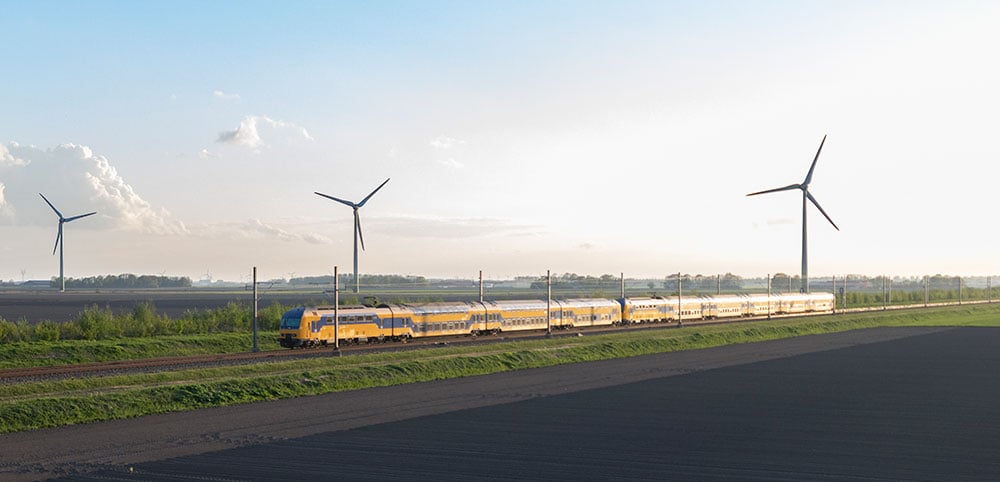Decarbonizing rail transportation: Creating innovative solutions to complement operations
Three major technology options have emerged to help meet sustainability goals: contact, battery, and hydrogen-based systems. Each offers potential benefits and drawbacks which must be carefully evaluated specific to railroad operations. Hatch is working at the forefront of these technology deployments and is partnering with our clients to select the right technology for their operations.
Contact-based electrical power distribution
The most efficient and established method to provide sustainable rail transportation is using contact-based electrical power distribution such as overhead contact systems or third rail. The primary drawbacks with this technology are that it involves a high initial capital cost to construct and can often require major political efforts to complete due to regulatory and stakeholder issues. As a result, the majority of the North American rail network is not electrified, instead relying on fossil-fueled power to support operations. Currently operations with high density rail traffic, such as metro lines, are the most likely to be electrified, as the benefits are more quickly realized than on less traveled freight networks.

Battery-based energy storage
Due to the challenges of implementing contact-based systems, operators have recently looked to store clean energy on board rail vehicles. The primary technology being explored is battery-based energy storage. Hatch has been helping to deploy this technology for decades, supporting projects such as streetcars in the US that use batteries that are charged by traditional contact systems and travel on battery power through short off wire segments. The primary drawbacks with batteries are their low energy density, charging infrastructure requirements, lengthy charge times, and heavy weight. These factors limit the range that battery powered rail vehicles can provide and are therefore primarily useful for short distance and low traffic density operations.
Hydrogen
Hydrogen trains offer increased range over battery-based designs and can be fueled much faster than the time required to charge battery-based energy storage systems. The primary drawbacks with hydrogen are related to lower energy efficiency, the sustainability of hydrogen production, sourcing the fuel and infrastructure requirements. There are efficiency losses that occur when hydrogen powered vehicles convert the chemical energy in hydrogen gas into electrical energy; around a quarter of the electricity is automatically lost. Furthermore, hydrogen is not typically found as a natural chemical element, which complicates the generation-to-consumer process. Instead, hydrogen has to be extracted from compounds such as water or methane which requires immense energy, and production can create emissions in the process. For these reasons, hydrogen is best applied to longer range routes to exploit its benefits, and in operations that have lower traffic density to limit the effect of reduced efficiencies.
Energy modeling for intelligent transportation and sustainability
To help our clients evaluate the benefits and drawbacks of each of these technologies, Hatch developed the industry leading simulation tool Energy Modeling for Intelligent Transportation and Sustainability (EMITS). EMITS has been used to model all types of rail operations including freight and passenger transportation. Hatch uses EMITS to conduct comparative analyses between these three technologies and determine the optimal solution for each of our clients. It’s vital to assess the financial, operational, workforce, and infrastructure implications of each technology. Numerous alternative technology scenarios must be evaluated; because one technology solution may disproportionately benefit one part of an organization, such as the operations, but have challenging infrastructure requirements, as an example, it’s vital to weigh tradeoffs using a quadruple-bottom-line approach to select an optimal solution.
EMITS: Transformative Transportation Simulation
Hatch developed a proprietary software tool called Energy Modeling for Intelligent Transportation and Sustainability (EMITS) to provide hyper-accurate simulations of zero emission transportation. EMITS evaluates vehicles on diesel, gasoline, natural gas, electricity, batteries, blended fuels, or hydrogen. It considers variables like vehicle weight, battery age, weather, route topography, and more. Clients gain a comprehensive view of transitioning to zero-emission or low-emission technology, enabling strategic decision-making. EMITS conducts feasibility studies, planning reports, and custom simulations. It develops precise speed profiles, models vehicles based on physics principles, and automates simulations with intelligent control algorithms. With a collaborative, conflict-free approach, EMITS is a game-changing partner in recommending technologies and solutions tailored to clients' unique needs.What’s next?
Late last year, Hatch visited Quebec to take a ride on North America’s first hydrogen powered passenger rail vehicle. This hydrogen train had been operating on a German rail line since 2019 and was imported to Quebec as a demonstration, with rail operators in California also set to receive hydrogen powered trains in the near future.

As the threats of climate change continue to grow, it’s heartening to see ways the rail industry continues to explore options for decarbonization. We anticipate that contact, battery, and hydrogen-based systems will increase in prevalence, and that technology will continue to improve.
Hatch stands ready to support the industry by leveraging our decades of experience and cutting-edge tools to provide each operator with confidence that the technology selected best suits its operations.
